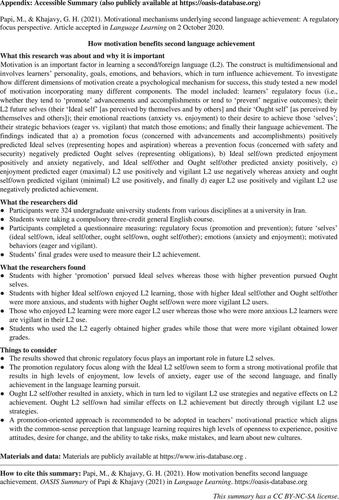当前位置:
X-MOL 学术
›
Lang. Learn.
›
论文详情
Our official English website, www.x-mol.net, welcomes your
feedback! (Note: you will need to create a separate account there.)
Motivational Mechanisms Underlying Second Language Achievement: A Regulatory Focus Perspective
Language Learning ( IF 3.5 ) Pub Date : 2021-01-05 , DOI: 10.1111/lang.12443 Mostafa Papi 1 , Gholam Hassan Khajavy 2
Language Learning ( IF 3.5 ) Pub Date : 2021-01-05 , DOI: 10.1111/lang.12443 Mostafa Papi 1 , Gholam Hassan Khajavy 2
Affiliation

|
We tested a theoretical model that integrated regulatory focus, second language (L2) self-guides, anxiety and enjoyment, eager and vigilant L2 use, and L2 achievement. We collected data from 324 students learning English as a foreign language. Structural equation modeling results showed that (a) the promotion focus positively predicted ideal selves, whereas the prevention focus negatively predicted ought selves; (b) ideal self/own predicted enjoyment positively and anxiety negatively, ought self/other and ideal self/other predicted anxiety positively, and ought self/own positively predicted vigilant L2 use; (c) enjoyment predicted eager L2 use positively and vigilant L2 use negatively, whereas anxiety predicted vigilant L2 use positively; and finally (d) eager L2 use positively and vigilant L2 use negatively predicted achievement. The findings suggest that a promotion-oriented approach to language learning and teaching might lead to more adaptive motivational, emotional, and behavioral patterns, which in turn contribute to language learning success. Theoretical and educational implications are discussed.
中文翻译:

第二语言成就背后的动机机制:监管焦点
我们测试了一个理论模型,该模型整合了监管重点,第二语言(L2)自我指导,焦虑和享受,对L2的渴望和警觉使用以及L2的成就。我们收集了324名学习英语作为外语的学生的数据。结构方程模型的结果表明:(a)促进重点是积极预测的理想自我,而预防重点是积极预测的理想自我;(b)理想的自我/自己对享乐的期望是积极的,而对焦虑的期望是负面的;理想的自我/自己和理想的自我/他人的期望是积极的,对焦虑的期望应该是积极的,并且应该对自我/自己对警惕的L2的使用做出积极的预测;(c)乐于预测渴望的L2积极使用,而警惕L2则使用消极,而焦虑则预期警惕的L2使用积极;最后(d)渴望L2积极使用,而警惕性L2则使用负面的预测成绩。研究结果表明,以促进为导向的语言学习和教学方法可能会导致更具适应性的动机,情感和行为方式,进而促进语言学习的成功。理论和教育意义进行了讨论。
更新日期:2021-01-05
中文翻译:

第二语言成就背后的动机机制:监管焦点
我们测试了一个理论模型,该模型整合了监管重点,第二语言(L2)自我指导,焦虑和享受,对L2的渴望和警觉使用以及L2的成就。我们收集了324名学习英语作为外语的学生的数据。结构方程模型的结果表明:(a)促进重点是积极预测的理想自我,而预防重点是积极预测的理想自我;(b)理想的自我/自己对享乐的期望是积极的,而对焦虑的期望是负面的;理想的自我/自己和理想的自我/他人的期望是积极的,对焦虑的期望应该是积极的,并且应该对自我/自己对警惕的L2的使用做出积极的预测;(c)乐于预测渴望的L2积极使用,而警惕L2则使用消极,而焦虑则预期警惕的L2使用积极;最后(d)渴望L2积极使用,而警惕性L2则使用负面的预测成绩。研究结果表明,以促进为导向的语言学习和教学方法可能会导致更具适应性的动机,情感和行为方式,进而促进语言学习的成功。理论和教育意义进行了讨论。











































 京公网安备 11010802027423号
京公网安备 11010802027423号